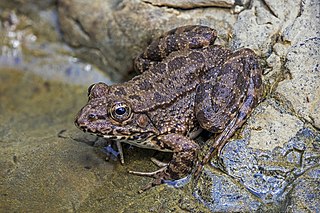
True frogs is the common name for the frog family Ranidae. They have the widest distribution of any frog family. They are abundant throughout most of the world, occurring on all continents except Antarctica. The true frogs are present in North America, northern South America, Europe, Africa, and Asia. The Asian range extends across the East Indies to New Guinea and a single species, the Australian wood frog, has spread into the far north of Australia.

George Albert Boulenger was a Belgian-British zoologist who described and gave scientific names to over 2,000 new animal species, chiefly fish, reptiles, and amphibians. Boulenger was also an active botanist during the last 30 years of his life, especially in the study of roses.

The Rhacophoridae are a family of frogs that occur in tropical sub-Saharan Africa, South India and Sri Lanka, Japan, northeastern India to eastern China and Taiwan, south through the Philippines and Greater Sundas, and Sulawesi. They are commonly known as shrub frogs, or more ambiguously as "moss frogs" or "bush frogs". Some Rhacophoridae are called "tree frogs". Among the most spectacular members of this family are numerous "flying frogs".

The Rhacophorinae are a subfamily of frogs in the family Rhacophoridae. They range from tropical Africa and Asia to temperate China and Japan.

Conraua, known as slippery frogs or giant frogs is a genus of large frogs from sub-Saharan Africa. Conraua is the only genus in the family Conrauidae. Alternatively, it may be placed in the family Petropedetidae.
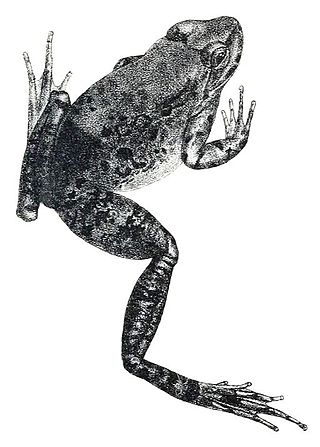
Nanorana is a genus of dicroglossid frogs. They are found in Asia, from the Himalayan region of northern Pakistan and northern India, Nepal, and western China east to montane southern China and southeast to Myanmar, Thailand, Laos, and northern Vietnam. Common names of these frogs reflect the complex taxonomic history of the genus and include Yunnan slow frogs and High Himalaya frogs.

Leptolalax is a genus of frogs in the family Megophryidae. They are sometimes known as Asian toads, metacarpal-tubercled toads, or slender litter frogs, although many species-specific common names do not follow these conventions, and many species do not have common names. They are widely distributed in southeastern and eastern Asia, from southern China and northeastern India to the Malay Peninsula and Borneo. Leptolalax are typically small and have a cryptic colour pattern and no obvious morphological characters useful in systematic studies. Consequently, both molecular genetic analyses and analysis of advertisement calls by male frogs have been important in identifying new species.
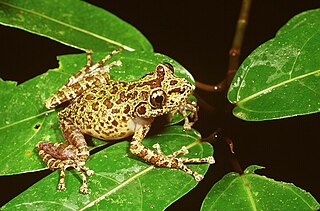
Spinomantis peraccae is a species of frog in the mantellid subfamily Mantellinae. It is endemic to Madagascar and widely distributed in the northern, eastern, and central parts of the island. The specific epithet honours Italian herpetologist Mario Giacinto Peracca. Common name Peracca's Madagascar frog has been coined for it.

Amietia is a genus of frogs, commonly known as large-mouthed frogs or river frogs, in the family Pyxicephalidae. They are endemic to central and southern Africa. Formerly, the genus was named Afrana and was placed in the family Ranidae.

Humerana lateralis is a species of frog in the family Ranidae. It is found in Cambodia, Laos, Myanmar, Thailand, and Vietnam. It is commonly known as Kokarit frog, yellow frog or (ambiguously) wood frog.
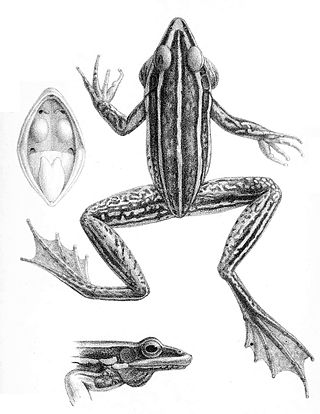
Humerana oatesii is a species of frog in the family Ranidae. It is endemic to Burma. This species is only known from type series collected from "near Toungoo" in the Pegu Range. The specific name oatesii honours Eugene W. Oates, English civil servant and naturalist who collected the type series. However, the common name Toungoo frog has been proposed for it.

Guibemantis is a frog genus in the mantellid subfamily Mantellinae. This genus is restricted to Madagascar. At present it contains 16 species divided into two subgenera.

The Ceratobatrachidae are a family of frogs found in the Malay Peninsula, Borneo, the Philippines, Palau, Fiji, New Guinea, and the Admiralty, Bismarck, and Solomon Islands.
Humerana miopus, also known as the Khao Wang frog or three-striped frog, is a frog that was identified in 1918. This species is known from southern Thailand and Peninsular Malaysia, and it is locally common.
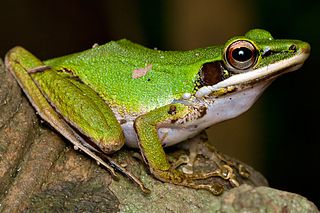
Chalcorana is a genus of frogs in the family Ranidae, "true frogs". They are found in Southeast Asia, from Thailand to Malay Peninsula and the Sunda Islands.
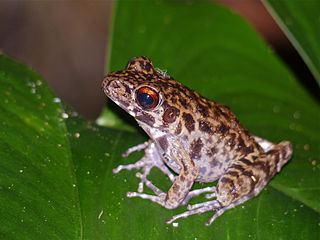
Pulchrana is a genus of ranid frogs found in south-eastern Asia, Indonesia and the Philippines.

Sanguirana is a genus of true frogs found in the Malay Archipelago, including the Philippines, the Maluku Islands, Sulawesi, and Seram.

Nidirana is a genus of true frogs (Ranidae) from East and Southeast Asia. They are commonly known as music frogs. This genus contains numerous species that were formerly classified in the genus Babina, which is thought to be its sister genus.

















